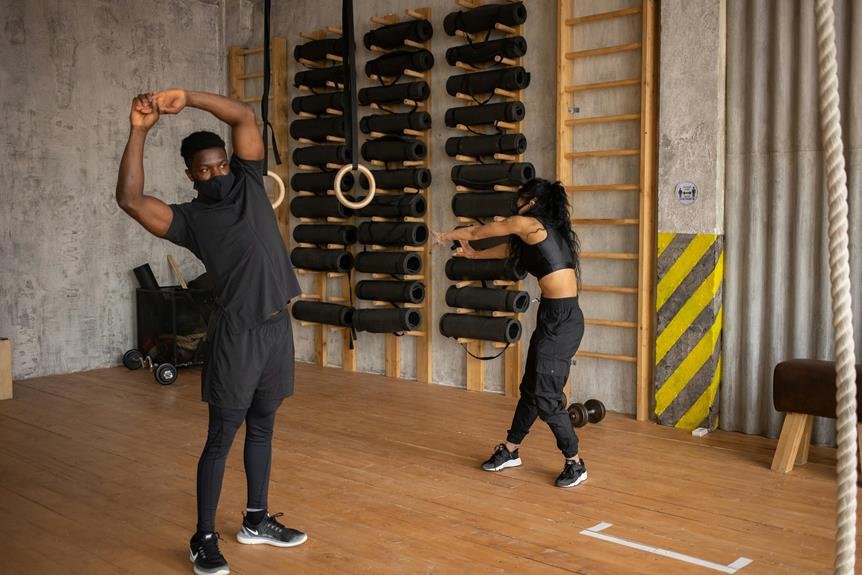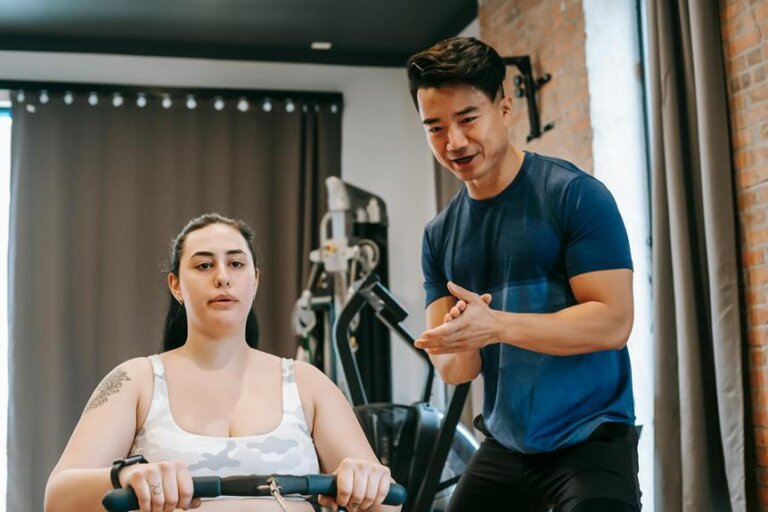Best Practices for Preventing Injuries During Exercise
When it comes to keeping your body in top shape while working out, it's crucial to remember that an ounce of prevention is worth a pound of cure. By implementing a few simple strategies, you can significantly reduce your risk of exercise-related injuries.
From warming up properly to paying attention to your form, taking these precautions can make all the difference in your fitness journey.
But what are the key practices you should focus on to ensure a safe and effective workout routine?
Proper Warm-Up Techniques
Before engaging in any physical activity, make sure to properly warm up your muscles to prevent injuries. Warming up is crucial as it increases blood flow to your muscles, preparing them for more intense exercise. Begin with light aerobic activities like jogging or jumping jacks to gradually raise your heart rate. This helps loosen your muscles and joints, reducing the risk of strains or sprains during your workout.
Incorporating dynamic stretches into your warm-up routine can further help prevent injuries. Perform movements that mimic the activity you're about to do, such as leg swings or arm circles. Dynamic stretches improve flexibility and range of motion, enhancing your performance while reducing the chance of muscle tears.
Additionally, consider adding some bodyweight exercises like squats or lunges to your warm-up. This not only activates multiple muscle groups but also mentally prepares you for the upcoming workout. Remember, taking just a few extra minutes to warm up properly can make a significant difference in preventing exercise-related injuries.
Importance of Stretching Exercises
Ensuring proper stretching exercises in your routine is crucial for enhancing flexibility and preventing muscle injuries. Stretching helps improve the range of motion in your joints, allowing you to move more freely during exercise and reducing the risk of strains or sprains. It also promotes better blood circulation to the muscles, helping them perform more efficiently and recover faster after workouts.
Incorporating dynamic stretches before your workout and static stretches after can help prepare your muscles for the activity ahead and prevent tightness post-exercise. Dynamic stretches involve moving parts of your body through a full range of motion, warming up the muscles and increasing blood flow. Static stretches, on the other hand, involve holding a stretch for a prolonged period, which can help improve flexibility over time.
Remember to focus on major muscle groups like hamstrings, quadriceps, calves, and shoulders when stretching. By making stretching a regular part of your routine, you can enhance your overall performance, reduce the likelihood of injuries, and improve your fitness level in the long run.
Correct Form and Technique Emphasis
To prevent injuries during exercise, it's crucial to focus on correct form and technique emphasis. Proper form is essential in maximizing the effectiveness of your workout while minimizing the risk of injury. When performing exercises, pay attention to the alignment of your body, the positioning of your joints, and the range of motion. Engaging the correct muscles and moving in a controlled manner not only enhances the benefits of the exercise but also reduces the strain on your muscles and joints.
Emphasizing technique ensures that you're targeting the right muscle groups and not putting unnecessary stress on other areas. For example, during weightlifting, using the correct posture and technique can prevent back injuries and strain. In activities like running or cycling, maintaining proper form can help prevent overuse injuries and improve efficiency.
Gradual Progression in Intensity
Starting slowly and gradually increasing the intensity of your workouts is key to preventing injuries and improving your fitness level. Jumping into intense workouts without proper progression can strain your muscles and lead to injuries. By gradually increasing the intensity of your exercises, you allow your body to adapt and become stronger over time.
When you push yourself too hard too quickly, you risk overloading your muscles and joints, which can result in strains, sprains, or even more serious injuries. It's important to listen to your body and progress at a pace that feels challenging but manageable. This approach not only reduces the risk of injury but also helps you build endurance and strength more effectively.
To implement gradual progression in intensity, start by choosing exercises that align with your current fitness level. Then, slowly increase the weight, duration, or intensity of your workouts as your body becomes accustomed to the demands. Remember, slow and steady progress is the key to long-term success in your fitness journey.
Listening to Body Signals
Paying attention to subtle cues from your body is crucial for avoiding injuries and maximizing the effectiveness of your workouts. Your body communicates with you during exercise, providing signals that can indicate whether you're pushing yourself too hard or if everything is going smoothly. Listen to these signals – if you experience sharp pain, dizziness, or shortness of breath, stop immediately. These are red flags that shouldn't be ignored.
On the other hand, feeling a moderate level of fatigue or muscle burn is normal and even beneficial for progress. Recognize the difference between discomfort and actual pain. It's important to know when to push through and when to back off to prevent overexertion and injury.
Additionally, pay attention to your posture and form. Any feelings of strain or awkwardness could be a sign that you need to adjust your technique. By staying attuned to your body's messages, you can tailor your workouts to suit your needs, ultimately leading to safer and more effective exercise sessions.
Frequently Asked Questions
How Can I Modify My Exercise Routine to Accommodate a Specific Injury or Condition?
To modify your exercise routine for a specific injury or condition, focus on low-impact activities, warm up properly, and listen to your body. Consult a healthcare professional for tailored advice and exercises to safely accommodate your needs.
What Are Some Common Mistakes People Make That Lead to Exercise-Related Injuries?
When you push too hard, skip warm-ups, neglect proper form, or ignore rest days, you risk exercise-related injuries. Remember, pacing yourself, warming up, using correct technique, and allowing your body to recover are essential to prevent injuries.
How Can I Prevent Overtraining and Burnout While Still Making Progress in My Fitness Goals?
To prevent overtraining and burnout while progressing in fitness goals, listen to your body, vary workouts, prioritize rest days, and fuel your body properly. Balance intensity with recovery to ensure long-term success and enjoyment in your fitness journey.
What Role Does Nutrition Play in Preventing Injuries During Exercise?
To prevent injuries during exercise, nutrition plays a crucial role. Eating a balanced diet with sufficient protein, carbs, and healthy fats helps support muscle strength, repair, and overall performance. Stay hydrated and fuel your body right for optimal workout recovery.
Are There Any Specific Exercises or Stretches That Can Help Target Common Problem Areas Prone to Injury?
To target common problem areas prone to injury, focus on exercises and stretches that strengthen and improve flexibility in those specific areas. Consistent practice of these targeted movements can help reduce the risk of injuries during exercise.
Conclusion
Overall, remember to prioritize safety during your exercise routine by implementing these best practices.
By properly warming up, stretching, focusing on form, gradually increasing intensity, and listening to your body, you can significantly reduce the risk of injuries.
Consistency and mindfulness in your approach won't only help prevent injuries, but also improve your overall fitness level and performance.
Stay safe and enjoy your workouts!






